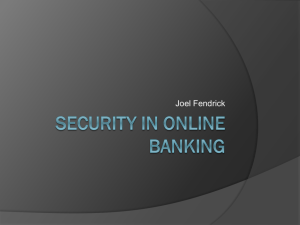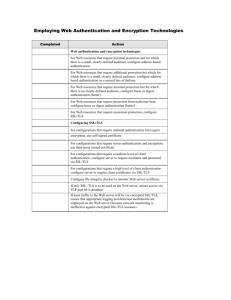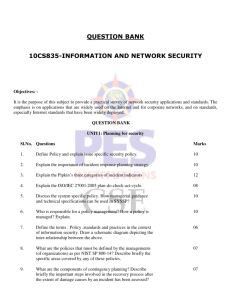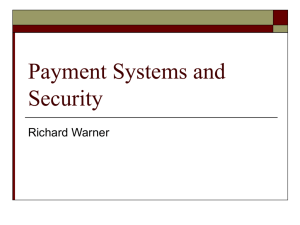323 - ClassicCMP
advertisement
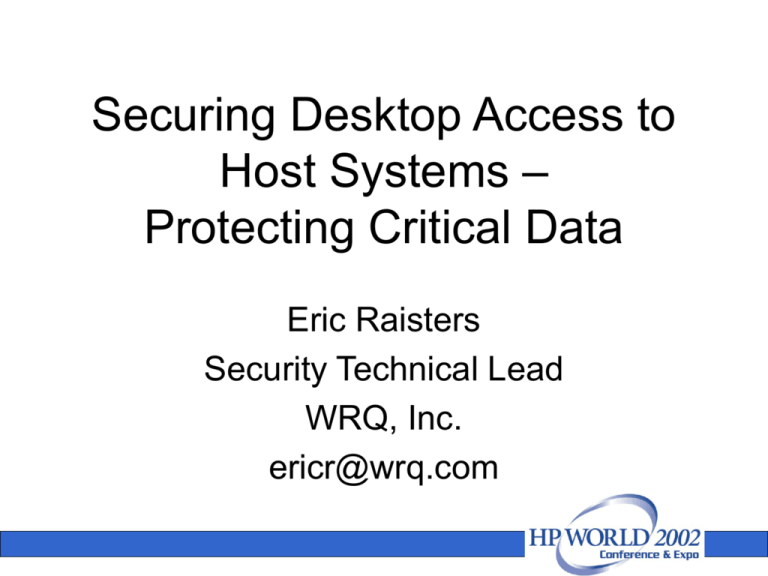
Securing Desktop Access to Host Systems – Protecting Critical Data Eric Raisters Security Technical Lead WRQ, Inc. ericr@wrq.com What’s the problem? • 70 - 80% of security breaches come from inside the firewall. (FBI and CSI surveys as recent as 2000) • New regulations (e.g. HIPAA) require confidential data to be transmitted securely. • Popularity of the Internet increases risk. – B2B/Web services – Working from home Assumptions • Securing the desktop is a whole topic on it’s own. • Both desktop and host systems have a base level of security. • The network between them is not secure. • This is geared towards desktops running Windows, but could equally apply to other desktops. Proprietary Products - Pluses • More difficult to crack if don’t know algorithm; have to reverse-engineer • Usually better administration utilities, services, and documentation Open Source/Standard Pluses • Lots of eyes and hands working on it • Not dependent on the trustworthiness of several programmers or one company • Algorithms proven to be cryptologically sound The Three A’s of Network Security • Authentication – proving who you are – getting proof back (mutual authentication) • Authorization – proving what resources you may use • Audit – logging who has done what – primarily a server-side responsibility • [Administration] How Do We Securely Communicate? PC ?????????????????? PC Host Firewall Historically - Clear Text “Security Through Obscurity” PC Data Password Name PC Host Firewall Middleware Model (Proxy) PC PC Encrypted Clear text Data Password Name Proxy Server Data Password Name Proxy Server Firewall Firewall Host Encrypted Tunnels Model (Direct) PC Encrypted Data Password Name PC Host Firewall VPN (via IPSec) Basics 1. Use IKE to negotiate Phase 1 SA VPN Client 3. Encrypt packets with outbound SA 6. Decrypt packets using inbound SA and send to application 2. Negotiate Phase 2 SA (inbound & outbound SA) VPN Server 4. Decrypt packets using inbound SA and send to application 5. Encrypt packets using outbound SA SOCKS Clients - Features • Standard protocol developed by NEC – Application client makes a request to SOCKS to communicate with the application server. – On behalf of the application client, SOCKS establishes a proxy circuit to the application server, then relays the application data between the client and the server. • Designed for traversing TCP-based client/server applications • Version 5 provides secure authentication and encryption with GSSAPI SOCKS Client - Pluses • • • • Standards-based protocol Facilitates firewall traversal Widely available in client programs Can be used regardless of the protocol the application uses • Imposes little overhead on network communications SOCKS Client - Minuses • May require identd running on client PC (requires the use of DNS server or relay) • Requires that applications be modified to become “SOCKSified” • Additional server to administer that may be separate from network servers SSL / TLS / OpenSSL • SSL (Secure Sockets Layer) v3.x – proprietary protocol originally developed by Netscape for Web (HTTP) security – the de facto security standard for the Web • TLS (Transport Layer Security) v1.0 – standards-based version that uses opensource algorithms – currently an IETF draft SSL / TLS - Features • Uses public key cryptography and X.509 certificates to authenticate • Negotiates session keys for symmetric encryption • Includes 56-bit DES, 128-bit RC-4, 168-bit 3DES encryption • Provides data integrity and encryption SSL / TLS Basics 1. Establish secure tunnel 2. Authenticate SSL / TLS server Client 3. Authenticate client (optional) SSL / TLS Server or Gateway 4. Encrypted session 5. Unencrypted session Telnet Server SSL / TLS - Pluses • Proven technology for securing the Web • IETF standard coming (IBM is pushing) • OpenSSL available for UNIX/Linux SSL / TLS - Minuses • Open standard may not interoperate with proprietary SSL — different key negotiation and encryption algorithms • Certificates difficult to administrate • Not many choices for Telnet or FTP server vendors (primarily IBM big iron) • Possible trademark and royalty issues Kerberos • Created at MIT in the early 1980s • Current open-standard version is 5.0 • Used for authentication, data integrity, and encryption • Implemented in Windows 2000 and XP via the Security Service Provider Interface (SSPI) Kerberos - Features • Secure authentication – Password never travels over the network – Memory-only credentials caches • Data stream protections – Detection of data stream modification – 56-bit DES or 168-bit 3DES encryption – Telnet, FTP, rlogin, rcp, rsh protocols Kerberos Basics 1. Request TGT Kerberos Client 2. Return TGT KDC Domain 3. Using TGT, request ST Controller 4. Return ST 5. Present ST 6. Encrypted session Telnet, FTP, etc. Server Kerberos - Pluses • Mature, open standard that’s never been broken • Minimal administration and server overhead • Programmatic access - GSSAPI • Widely available for UNIX/Linux, Windows, Unisys, OpenVMS, • No patent or royalty encumbrances Kerberos - Minuses • The KDC(s) must be secured • Prone to offline attacks on TGT; brute force attacks feasible on 56-bit keys • Significant cost of implementation – Requires applications be “kerberized” – Administrators require specialized training Secure Shell (SSH) • Provides strong authentication password, public key, Kerberos • SSH-1 (deprecated) and SSH-2 • Replaces Telnet, rlogin, rsh, and rcp • Secure forwarding of TCP connections, including X-11 protocol • FTP replacement sftp in SSH-2 Secure Shell - Features • 56-bit DES, 168-bit 3DES, 128-bit Arcfour, 128-bit CAST, 443-bit Blowfish and AES algorithms up to 256-bits • OpenSSL libraries used for SSH-1 compatibility Secure Shell Basics 1. Establish secure tunnel Secure 2. Authenticate Shell server Client 3. Authenticate Secure Shell Server client 4. Encrypted session OS TCP Stack 5. Arbitrary TCP port forwarding OS TCP Stack Secure Shell - Pluses • • • • • Internet draft, open-source standard Only one firewall port open No patent or royalty encumbrances Protocol-independent Available on UNIX/Linux, OpenVMS, Windows Secure Shell - Minuses • Administration problems – Certificates difficult to manage in timely manner if using user key – Specialized administration required if using Kerberos • Requires regular security updates as bugs and holes are identified and fixed in the open-source implementation. Security Availability Secure SOCKS SSL/ Kerberos Shell TLS VPN UNIX/Linux * OpenVMS Only through middleware servers MPE Mainframe s Unisys Windows * Questions? Thank you!

